Story of Maharaja Ranjit Singh
The Lion of Punjab
 Maharaja Ranjit Singh Portrait
Maharaja Ranjit Singh PortraitThe story of Maharaja Ranjit Singh is an interesting historical read with full of challenges and triumphs.
It is one of the most fascinating tales in Indian history.
Ranjit Singh was known as the "Lion of Punjab."
He was a remarkable ruler who united the Punjab region and created one of the most powerful kingdoms in 19th-century India.
His story is inspiring and encouraging, showing how a young boy overcame physical challenges to become one of India's greatest warriors and administrators.
Early Life of Maharaja Ranjit Singh
Maharaja Ranjit Singh was born on November 13, 1780, in Gujranwala, which is now in present-day Pakistan.
He came into this world during a time of great political turmoil in the Punjab region.
His father, Maha Singh, was the leader of the Sukerchakia Misl, one of the twelve Sikh confederacies that controlled different parts of Punjab at that time.
Ranjit Singh, from birth, faced such challenges that could have discouraged many others.
He lost sight in his left eye due to smallpox when he was just a child.
This physical disability could have limited his future, but instead, it seemed to strengthen his determination.
His family and community showed great sympathy and support during his recovery, which helped shape his compassionate nature as a future ruler.
Childhood Struggles and Early Leadership
The early childhood of Maharaja Ranjit Singh was marked by constant warfare and political instability.
The Punjab region was divided among various Sikh misls (confederacies), and each group was fighting for control of territory and resources.
This environment taught young Ranjit the importance of military strategy and political alliances from a very early age.
When Ranjit Singh was only ten years old, his father, Maha Singh, died in 1790.
This tragic event thrust the young boy into a position of leadership much earlier than anyone expected.
Despite his youth, he showed remarkable maturity and began learning the art of governance and warfare under the guidance of his mother, Raj Kaur, and other trusted advisors.
His mother, Raj Kaur, played a crucial role in his early development.
She was a strong and intelligent woman who understood the political landscape of Punjab.
She made sure that her son received a proper education in both military tactics and administrative skills.
Her influence helped shape Ranjit Singh into a balanced leader who valued both strength and wisdom.
Rise to Power: From Young Warrior to Maharaja
As a teenager, Ranjit Singh began participating in military campaigns alongside experienced warriors.
These early experiences on the battlefield taught him valuable lessons about leadership, strategy, and the importance of maintaining strong relationships with his soldiers.
He quickly gained a reputation as a brave and intelligent young commander.
The story of Maharaja Ranjit Singh's rise to power began in earnest when he was just nineteen years old.
In 1799, he captured the city of Lahore, which was then controlled by Afghan forces.
This victory was significant because Lahore was considered the heart of Punjab, and controlling it meant influencing the entire region.
After capturing Lahore, Ranjit Singh was proclaimed Maharaja of Punjab on April 12, 1801.
This coronation marked the beginning of the Sikh Empire, which eventually became one of the most powerful kingdoms in the Indian subcontinent.
At just twenty years old, he had achieved what many seasoned warriors could only dream of.
Marriages and Family Relations
One of the most interesting aspects of Maharaja Ranjit Singh's personal life was his approach to marriage.
Unlike many rulers of his time who married for purely political reasons, Ranjit Singh's marriages were a combination of love, political alliance, and personal choice.
He had multiple wives, which was common for rulers of that era.
First Marriage and Early Alliances
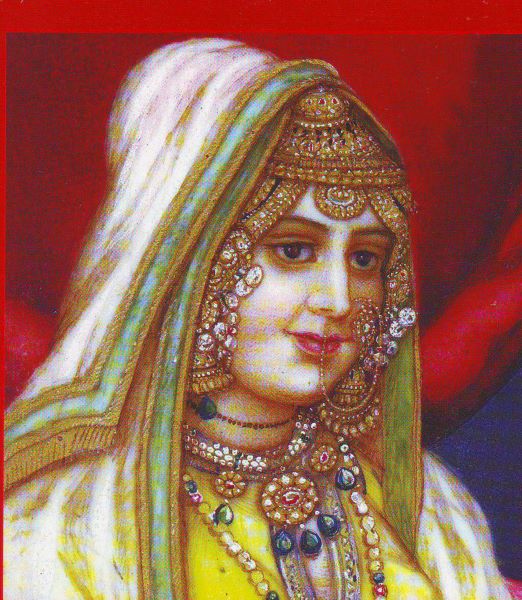 Mehtab Kaur - wife of Maharaja Ranjit Singh
Mehtab Kaur - wife of Maharaja Ranjit SinghHis first marriage was to Mehtab Kaur in 1796 when he was just sixteen years old.
This marriage was arranged by his mother and was meant to strengthen political alliances between different Sikh families.
Mehtab Kaur came from a respected Sikh family and proved to be a supportive partner during the early years of his reign.
Marriage to Datar Kaur
 Datar Kaur - wife of Maharaja Ranjit Singh
Datar Kaur - wife of Maharaja Ranjit SinghRanjit Singh's second significant marriage was to Datar Kaur, who became one of his most beloved wives.
She was known for her beauty and intelligence, and their relationship was said to be based on genuine affection.
Datar Kaur gave birth to his son Kharak Singh, who later bacome his successor.
Later Marriages and Political Alliances
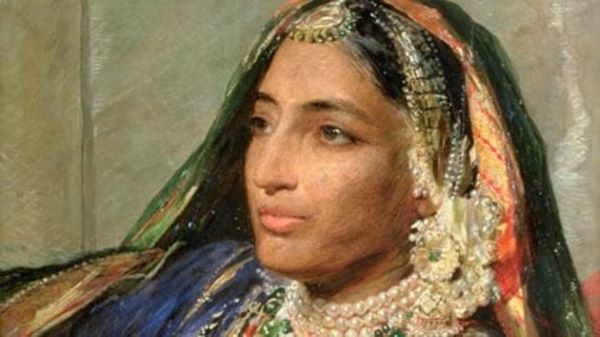 Jind Kaur - wife of Maharaja Ranjit Singh
Jind Kaur - wife of Maharaja Ranjit SinghAnother important marriage was with Maharani Jind Kaur, who was much younger than him.
This marriage took place later in his life, and Jind Kaur became the mother of Maharaja Duleep Singh, his youngest son.
She was known for her strong personality and political acumen, which became important after Ranjit Singh's death.
Ranjit Singh also married Raj Kaur, Daya Kaur, and several other women from different backgrounds.
These marriages helped him build strong political networks across Punjab and beyond.
He treated all his wives with respect and ensured they had comfortable lives and proper status in the royal court.
What made Ranjit Singh's approach to marriage unique was his tolerance and acceptance of different religions and cultures.
Some of his wives came from Hindu families, while others were from Sikh or Muslim backgrounds.
This diversity in his personal life reflected his broader philosophy of religious tolerance and unity.
Military Conquests of Maharaja Ranjit Singh
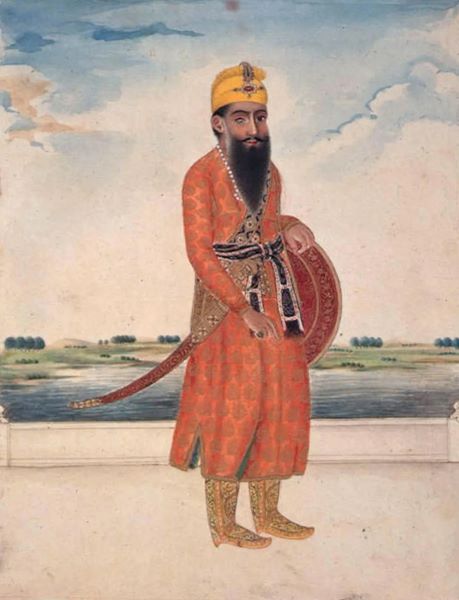 Maharaja Ranjit Singh as a Military Warrior
Maharaja Ranjit Singh as a Military WarriorThe military conquests of Maharaja Ranjit Singh began shortly after he became the ruler of Lahore.
His first major campaign was against the Afghan forces that still controlled parts of Punjab.
He understood that to create a stable kingdom, he needed to drive out all foreign invaders and unite the various Sikh misls under one banner.
Early Victories Against Afghan Forces
One of his most significant early victories came in 1802 when he defeated the Afghan governor of Kashmir.
This victory not only expanded his territory but also established his reputation as a formidable military commander.
The success encouraged other Sikh leaders to join his cause, gradually increasing the size and strength of his army.
Conquest of Amritsar: The Holy City
In 1805, Ranjit Singh achieved another major military success by capturing Amritsar, the holiest city for Sikhs.
This conquest was particularly important because it gave him control over the Golden Temple, the most sacred site in Sikhism.
Having control over Amritsar significantly increased his religious and political authority among the Sikh population.
The Siege of Multan
The conquest of Multan in 1818 was another milestone in Maharaja Ranjit Singh's military career.
Multan was a strategically important city that controlled trade routes between India and Central Asia.
The siege of Multan was challenging and required innovative military tactics, but Ranjit Singh's persistence and strategic thinking eventually led to victory.
Kashmir Campaign: Mountain Warfare
Maharaja Ranjit Singh's one of the most famous military achievements was the conquest of Kashmir in 1819.
Kashmir was a beautiful and wealthy region that had been under Afghan control for many years.
The campaign to capture Kashmir required careful planning and coordination of multiple military units across difficult mountain terrain.
The Kashmir campaign showcased Ranjit Singh's ability to adapt his military strategies to different types of terrain and enemies.
He used a combination of direct assault, siege warfare, and diplomatic negotiations to achieve victory.
The successful conquest of Kashmir significantly expanded his empire and increased his wealth through control of valuable trade routes.
Peshawar and the Northwestern Frontier
Another significant military achievement was his conquest of Peshawar in 1834.
Peshawar was an important city on the frontier between India and Afghanistan, and controlling it meant having influence over the strategic Khyber Pass.
This victory demonstrated that the Sikh Empire had become a major regional power.
Military Innovations and the Khalsa Army
Throughout his military campaigns, Maharaja Ranjit Singh showed remarkable strategic thinking and adaptability.
He was one of the first Indian rulers to modernize his army by incorporating European military techniques and equipment.
He hired foreign military advisors, including French and British officers, to train his soldiers in modern warfare methods.
His army, known as the Khalsa Army, became one of the most disciplined and effective fighting forces in Asia.
It included infantry, cavalry, and artillery units, all trained according to European military standards.
The army was also notable for its religious and ethnic diversity, including Sikhs, Hindus, Muslims, and even some Europeans.
One of the most remarkable aspects of Maharaja Ranjit Singh's military success was his ability to maintain discipline and loyalty among his diverse troops.
He treated his soldiers well, paid them regularly, and promoted based on merit rather than religion or social background.
This approach created a strong sense of loyalty and unity within his army.
Strategic Diplomacy and Military Tactics
Maharaja Ranjit Singh's military strategies were not just about conquest; they were also about consolidation and defense.
After capturing new territories, he immediately worked to integrate them into his empire by establishing effective administrative systems and building strong fortifications to protect against future attacks.
His approach to dealing with defeated enemies was often marked by mercy and pragmatism.
Rather than destroying his opponents, he often offered them positions in his administration or army if they proved their loyalty.
This policy helped him quickly stabilize newly conquered territories and reduce the risk of rebellions.
Relations with the British East India Company
The relationship between Maharaja Ranjit Singh and the British East India Company was complex and evolved over time.
Initially, both sides were cautious of each other but recognized the benefits of maintaining peaceful relations.
In 1809, they signed the Treaty of Amritsar, which established the Sutlej River as the boundary between their territories.
This treaty was significant because it allowed Ranjit Singh to focus on expanding his empire toward the west and north, while the British concentrated on their territories south and east of the Sutlej River. The agreement provided stability on both sides and prevented costly military conflicts that neither side really wanted at that time.
However, it would be incorrect to say that Ranjit Singh never fought against the British.
While he maintained official diplomatic relations with them, there were several instances of tension and minor conflicts.
He was always suspicious of British intentions and worked to strengthen his military capabilities as a deterrent against potential British aggression.
Ranjit Singh's intelligence network kept him well-informed about British military movements and political decisions.
He understood that the British were gradually expanding their control over other parts of India, and he was determined not to let the same thing happen to Punjab.
This awareness influenced many of his military and diplomatic decisions.
Administrative Genius and Religious Tolerance
One of the most inspiring aspects of Maharaja Ranjit Singh's character was his commitment to religious tolerance.
Despite being a Sikh ruler, he welcomed people of all faiths into his administration and army.
His court included Hindu ministers, Muslim generals, and even European advisors, creating a truly multicultural government.
This religious tolerance was not just a political strategy; it reflected his genuine belief in the equality of all people regardless of their faith.
He protected Hindu temples, Muslim mosques, and Sikh gurdwaras with equal dedication.
This approach helped create stability and unity within his diverse empire.
Cultural Renaissance and Economic Prosperity
Maharaja Ranjit Singh was also known for his patronage of arts, literature, and architecture.
During his reign, Punjab experienced a cultural renaissance with the construction of beautiful buildings, the promotion of poetry and music, and the development of new artistic styles that blended different cultural traditions.
His administrative system was highly effective and incorporated the best practices from different traditions.
He established a regular system of taxation, maintained detailed records of land ownership, and created efficient communication networks throughout his empire.
These administrative innovations helped maintain stability and prosperity in his territories.
The economic policies of Maharaja Ranjit Singh focused on promoting trade and agriculture.
He built roads, bridges, and canals to facilitate commerce and transportation.
His empire became prosperous through control of important trade routes and the development of local industries, particularly textiles and metalwork.
Education and Social Development
Education was another area where Ranjit Singh made significant contributions.
He established schools and libraries, promoted literacy, and encouraged the translation of important texts into local languages.
His support for education helped create a more informed and capable administrative class.
Final Years and Succession Challenges for Maharaja Ranjit Singh
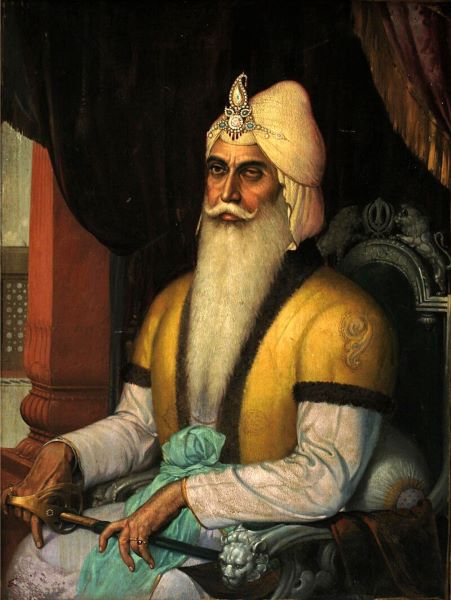
As Maharaja Ranjit Singh grew older, he began to face health problems that gradually weakened his ability to lead military campaigns personally.
However, he continued to oversee the administration of his empire and make important strategic decisions until near the end of his life.
The question of succession became increasingly important as his health declined.
He had several sons from different wives, and the issue of who would inherit the throne created some tension within the royal family.
This succession problem later contributed to the instability of the Sikh Empire after his death.
Death of Maharaja Ranjit Singh and the Immediate Aftermath
Maharaja Ranjit Singh died on June 27, 1839, at the age of 58 in Lahore.
His death marked the end of an era and the beginning of a period of instability for the Sikh Empire.
The loss of his strong leadership and unifying presence created opportunities for internal conflicts and external threats.
The immediate aftermath of his death saw a series of succession disputes and political intrigues that weakened the empire.
His son Kharak Singh became the next Maharaja, but he lacked his father's political skills and military acumen.
The empire began to fragment as different factions competed for power.
Legacy and Historical Impact
The legacy of Maharaja Ranjit Singh extends beyond his military conquests and political achievements.
He is remembered as a ruler who promoted unity, tolerance, and prosperity in a region that had been torn apart by constant warfare.
His example continues to inspire leaders who seek to build inclusive and just societies.
Modern historians recognize Ranjit Singh as one of the most effective rulers in Indian history.
His ability to create a stable, prosperous, and tolerant empire in such a challenging political environment demonstrates exceptional leadership skills.
His story encourages us to believe that determined individuals can overcome personal challenges and create positive change in the world.
Conclusion
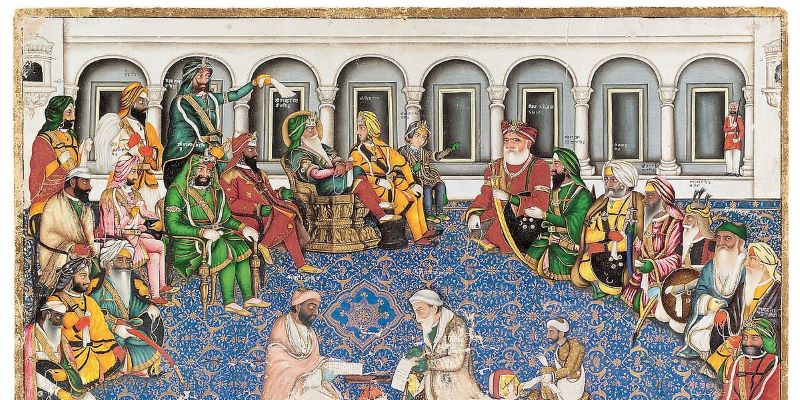 Maharaja Ranjit Singh Darbar
Maharaja Ranjit Singh DarbarThe history of Maharaja Ranjit Singh teaches us valuable lessons about leadership, tolerance, and perseverance.
Despite losing an eye in childhood and facing numerous political and military challenges, he built one of the most successful empires in Indian history.
The story of Maharaja Ranjit Singh continues to inspire people today, showing that with courage, wisdom, and determination, it is possible to achieve greatness while remaining true to one's values and principles.
You can read more about Maharaja Ranjit Singh at Wikipedia
NOTE: The images in the article may not be actual. These were created by later artists. They may not be the exact portrayal of the actual persons.

STAFF WRITER
IdeasBeat is an emerging eMagazine and a Multimedia Publishing House where we hunt for diverse ideas and stories from around the world. We share easy-to-digest articles and curated content from selected sources globally.